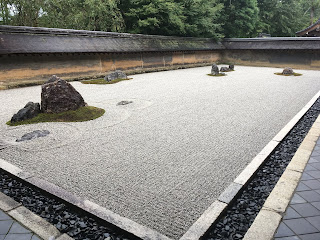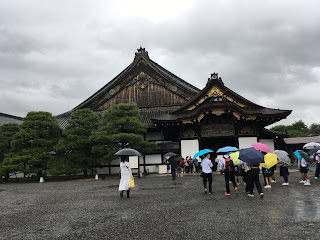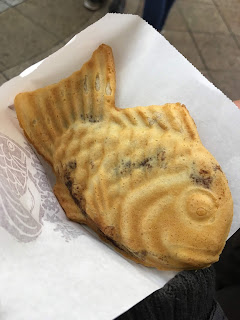12 days in Japan - Day 7 & 8 Kyoto
Ryoanji Temple
A zen temple known for its rock garden. The temple is part of the Myōshin-ji school of the Rinzai branch of Zen Buddhism. 15 rocks are situated in the garden and no matter where you stand, at least one of the rocks is always hidden. There are great views of the garden from the Hojo which is the head priest's former residence. Inside the Hojo, there are some interesting paintings on the sliding doors.Kinkakuji
Kinkakuji was the retirement house of the shogun Ashikaga Yoshimitsu and became a Zen temple of the Rinzai sect after his death. The Golden Pavillion is an iconic structure where two floors are constructed out of gold leaf. It was nice to walk around the gardens and admire The Golden Pavilion from different angles, but it was crowded and they do recommend going early morning where there is less people. The temple is outdoor which does mean exposure to all the elements so I would recommend bringing an umbrella, especially if it rains which it did for us.Kyoto Imperial Palace
The Kyoto Imperial Palace was the former residence of the Imperial Family until 1868, when the capital moved to Tokyo. It was interesting to see the emperor's different living quarters, ceremonial buildings, the official waiting rooms where guests were ushered into the different rooms according to their rank, the carriage entrance and the beautiful decorated gates. The gardens were very pretty surrounding the palace and would make a nice walk but due to the heavy rain, we decided to give this one a miss.
My friend had joined us for the day and took us to the tearoom, Toraya Ichijo. The tearoom is famous for their Japanese confectionary (wagashi), which changes according to the season. They also make great Sencha and green tea.
Nijo Castle
Built in 1603, Nijo Castle was the Kyoto residence of Tokugawa Ieyasu, the first shogun of the Edo Period. The main attraction is the Ninomaru Palace which was the residence and office of the shogun. Inside the rooms, the ceilings are beautifully decorated ceilings and the sliding doors are painted. Interestingly, the floors are nicknamed 'nightingale floors' as they were made to be squeaky like a nightingale's call to alert the occupants of intruders inside the Castle.Nishiki Market
This street is full of traditional market stalls selling all sorts of Japanese food from fresh seafood, vegetables, pickles to takoyaki and doughnuts. Its a great place for food with lots of options.A popular snack in Japan is Taiyaki, which is a fish-shaped cake with a filling such as red bean paste, custard, chocolate. You can find these on street market stalls and they are absolutely delicious when piping hot.
Day 8 - South Kyoto
Fushimi Inari-taisha Shrine
Widely recognised for its thousands of vermillion torii gates, Fushimi Inari-taisha Shrine is dedicated to Inari, the Shinto god of rice. You will notice the many fox statues around the shrine as foxes are believed to be Inari's messenger.The winding trail of vermillion torii gates leads into the forest of Mount Inari. The hike to the summit can be challenging with its numerous steps and takes around one hour to reach the top depending on how fast you walk. Along the way, there are shrines and miniature Torii gates,
We stopped at the Yotsutsuji intersection which took about 40 minutes and is roughly half way up the mountain. There are rest breaks here with views of the city and were told that the views are not much different to the summit, however you can continue up the mountain to the summit if you wanted.
Sanjusangendo Hall
Sanjusangendo Hall is widely recognised for its 1,001 life-sized statues of the goddess of mercy and compassion, Kannon. In the centre of the hall is a large wooden statue of a 1000-armed Kannon (Senju Kannon) to save those in need with the thousand standing statues of Kannon standing besides. There are also 28 statues of Buddhist guardian deities in front of the Kannon statues. The temple hall measures 120 meters and is the longest wooden structure in Japan. Interestingly, the wood is connected to one another with no nails.Yasaka Koshin-do Temple
This temple is dedicated to Shomen Kongo (Koshin-san), a guardian warrior who helps those people in need and punishes the bad. The temple also honours the Sanzaru, the three wise monkeys, which represent the Koshin beliefs. There are many bright fabric balls around the site called Kukurizaru that represent the monkey. Worshippers write their desires on these balls and hang them at the temple. According to Taoist belief we must sacrifice one of our desires to Koshin-san for a prayer to be granted.Kiyomizu-dera Temple
A spectacular buddhist temple on the slopes of Mt. Otowa in the eastern part of Kyoto. Known for its wooden Kiyomizu Stage, a veranda which hangs over the front of the main hall that offers stunning views of the city and surrounding cherry blossoms and maple trees. Amongst the noticeable features here is the Jishu Shrine dedicated to the deity of love and matchmaking, the Otowa Waterfall, the Shaka-do, Amida-do and Okuno-in. When we visited, the Main Hall was under renovation and was hidden under a brown cover.Related Posts
All images and material on the Under the Olive Branch blog are copyright protected and all rights reserved. Images and material are for personal viewing and evaluation only and are copyrighted @Undertheolivebranch unless otherwise indicated.












